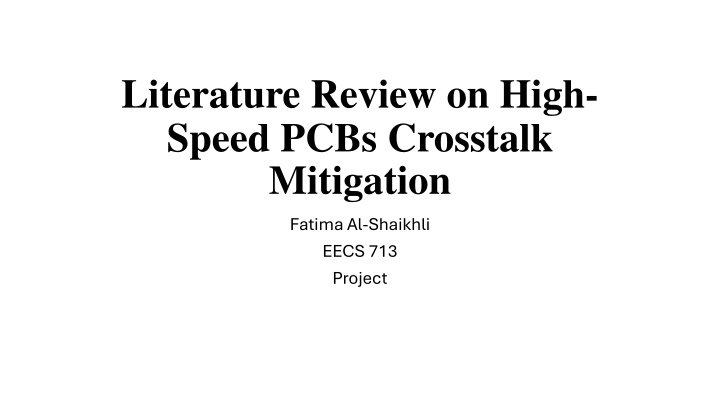
Mitigation Strategies for High-Speed PCBs Crosstalk Issues
Explore effective techniques for addressing crosstalk problems in high-speed PCBs, focusing on Far-end Crosstalk (FEXT) mitigation in Double Data Rate (DDR) designs. Learn about Tabbed Lines, Rectangular-Shape Resonators (RSR), and optimizing mutual capacitance to reduce crosstalk without compromising wire density.
Download Presentation

Please find below an Image/Link to download the presentation.
The content on the website is provided AS IS for your information and personal use only. It may not be sold, licensed, or shared on other websites without obtaining consent from the author. If you encounter any issues during the download, it is possible that the publisher has removed the file from their server.
You are allowed to download the files provided on this website for personal or commercial use, subject to the condition that they are used lawfully. All files are the property of their respective owners.
The content on the website is provided AS IS for your information and personal use only. It may not be sold, licensed, or shared on other websites without obtaining consent from the author.
E N D
Presentation Transcript
Literature Review on High- Speed PCBs Crosstalk Mitigation Fatima Al-Shaikhli EECS 713 Project
Crosstalk Problem in DDR Fast transfer of signal between CPU and memory chips DDR For high-speed data transfer in modern computers DDR = Double Data Rate memory bus which is a parallel signal bus FEXT is a major limiting factor for achieving higher data transfer rate FEXT = Far-end Crosstalk Most common way to avoid crosstalk is through avoidancee by increasing the separation between traces or increasing the separation between vias or adding ground bias At the expense of signal density for high-speed PCBs
FEXT Mitigation Far End Crosstalk is more problematic than Near-End Crosstalk for DDR designs FEXT Mitigation without comprising on wire density Design of the microstrip line to preserve or increase wiring density Tabbed Lines Intel Corporation Inserted RSR structures in coupled microstrip lines Zhang et al RSR = Rectangular-Shape Resonators
Couple Transmission Lines ?????? =1 ?????is the induced voltage at the receiving end of the victim line ??,?? Mutual Capacitance, Inductance ??,?? Self Capacitance, Inductance ?? propagation time ?? sum of self and mutual capacitance ??? applied voltage at the aggressor line ?? ?? ?? ?? ???? ?? 2 ?? ??
Principle of Design for Transmission Lines ?? ?? ?? The ?????? is proportional to Both presented methods aim to increase mutual capacitance without much increasing in the mutual inductance Optimize ?????? by reducing the difference between increases ?? amplitude Tapped Line method RSR structures in coupled microstrip lines ?? ?? ?? ?? ?? ??relative to ?? ??between circuit traces and thus modulates the crosstalk
Crosstalk Mitigation using Tabbed Lines Tabs added to wire edges, orthogonal to the direction of propagation Tabs effectively increase the ??between the lines without significantly increasing the ?? The magnitude and polarity of ?????? observed at end of line is determined by mode velocities along with length of the tabbed line section
Crosstalk Mitigation using Tabbed Lines Tabbed lines have two use cases Type 1: a segment of tabbed line signal trace that generates zero/minimum ?????? Scale in length, once designed it can be used for any routing length Type 2: a segment of tabbed line trace that minimizes or cancels out some portion of ?????? of an entire channel by generating ?????? of opposite polarity
Inserted RSR structures in coupled microstrip lines A novel method is proposed, where a defected microstrip structure (DMS) is etched on a microstrip transmission line, the rectangular-shape resonators (RSR) structure is placed between the coupled microstrip transmission lines The aggressor line is excited by a signal source at terminal port 1 and the other terminals are terminated with a 40
What to include in Report? Overview of the problem of crosstalk More detail into the design of the two different transmission lines included in this presentation Results and implication from this research
Sources R. K. Kunze, et al., Crosstalk mitigation and impedance management using tabbed lines, Intel, 2015. Zhang, et al. Far-End Crosstalk Mitigation for Microstrip Lines in High-Speed PCBs, Cross Strait Quad-Regional Radio Science and Wireless Technology Conference (CSQRWC), 2019.
